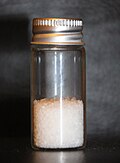Polyvinyl alcohol(PVOH,PVA,orPVAl) is awater-solublesynthetic polymer.It has the idealized formula [CH2CH(OH)]n.It is used inpapermaking,textile warp sizing,as a thickener and emulsion stabilizer inpolyvinyl acetate(PVAc) adhesive formulations, in a variety of coatings, and3D printing.It is colourless (white) and odorless. It is commonly supplied as beads or as solutions in water.[3][4]Without an externally added crosslinking agent, PVA solution can be gelled through repeated freezing-thawing, yielding highly strong, ultrapure,biocompatiblehydrogelswhich have been used for a variety of applications such asvascular stents,cartilages,contact lenses,etc.[5]
 | |
 | |
| Names | |
|---|---|
| Other names
PVOH; Poly(Ethenol), Ethenol, homopolymer; PVA; Polyviol; Vinol; Alvyl; Alcotex; Covol; Gelvatol; Lemol; Mowiol; Mowiflex, Alcotex, Elvanol, Gelvatol, Lemol, Nelfilcon A, Polyviol und Rhodoviol
| |
| Identifiers | |
| ChEMBL | |
| ChemSpider |
|
| ECHA InfoCard | 100.121.648 |
| E number | E1203(additional chemicals) |
| KEGG | |
| RTECS number |
|
| UNII | |
CompTox Dashboard(EPA)
|
|
| Properties | |
| (C2H4O)x | |
| Density | 1.19–1.31 g/cm3 |
| Melting point | 200 °C (392 °F; 473 K) |
| logP | 0.26[1] |
Refractive index(nD)
|
1.477 @ 632 nm[2] |
| Hazards | |
| NFPA 704(fire diamond) | |
| Flash point | 79.44 °C (174.99 °F; 352.59 K) |
| Lethal doseor concentration (LD, LC): | |
LD50(median dose)
|
14,700 mg/kg (mouse) |
| Safety data sheet(SDS) | External MSDS |
Except where otherwise noted, data are given for materials in theirstandard state(at 25 °C [77 °F], 100 kPa).
| |
Although polyvinyl alcohol is often referred to by theacronymPVA, more generally PVA refers topolyvinyl acetate,which is commonly used as a wood adhesive and sealer.
Uses
editPVA is used in a variety of medical applications because of its biocompatibility, low tendency for protein adhesion, and low toxicity. Specific uses includecartilagereplacements,contact lenses,laundry detergent podsandeye drops.[6]Polyvinyl alcohol is used as an aid insuspension polymerizations.Its largest application in China is its use as aprotective colloidto make PVAc dispersions. In Japan its major use is the production ofVinylonfiber.[7]This fiber is also manufactured inNorth Koreafor self-sufficiency reasons, because nooilis required to produce it. Another application is photographic film.[8]
PVA-based polymers are used widely in additive manufacturing. For example, 3D printed oral dosage forms demonstrate great potential in the pharmaceutical industry. It is possible to create drug-loaded tablets with modified drug-release characteristics where PVA is used as a binder substance.[9]
Medically, PVA-basedmicroparticleshave receivedFDA510(k)approval to be used asembolisationparticles to be used for peripheral hypervascular tumors.[10]It may also used as the embolic agent in a Uterine Fibroid Embolectomy (UFE).[11]In biomedical engineering research, PVA has also been studied forcartilage,orthopaedicapplications,[12]and potential materials forvascular graft.[13]
PVA is commonly used in household sponges that absorb more water thanpolyurethanesponges.[citation needed]
PVA may be used as an adhesive during preparation ofstool samplesfor microscopic examination inpathology.[14]
Polyvinyl acetals
editPolyvinylacetalsare prepared by treating PVA withaldehydes.Butyraldehydeandformaldehydeaffordpolyvinyl butyral(PVB) andpolyvinyl formal(PVF), respectively. Preparation of polyvinyl butyral is the largest use for polyvinyl alcohol in the US and Western Europe.
Preparation
editUnlike mostvinyl polymers,PVA is not prepared bypolymerizationof the correspondingmonomer,since the monomer,vinyl alcohol,is thermodynamically unstable with respect to itstautomerizationtoacetaldehyde.Instead, PVA is prepared by hydrolysis of polyvinyl acetate,[3]or sometimes other vinyl ester-derived polymers withformateorchloroacetategroups instead of acetate. The conversion of the polyvinyl esters is usually conducted by base-catalysedtransesterificationwith ethanol:
- [CH2CH(OAc)]n+ C2H5OH → [CH2CH(OH)]n+ C2H5OAc
The properties of the polymer are affected by the degree of transesterification.
Worldwide consumption of polyvinyl alcohol was over one million metric tons in 2006.[7]
Structure and properties
editPVA is anatacticmaterial that exhibitscrystallinity.In terms of microstructure, it is composed mainly of 1,3-diol linkages [−CH2−CH(OH)−CH2−CH(OH)−], but a few percent of 1,2-diols [−CH2−CH(OH)−CH(OH)−CH2−] occur, depending on the conditions for the polymerization of the vinyl ester precursor.[3]
Polyvinyl alcohol has excellent film-forming,emulsifyingandadhesiveproperties. It is also resistant to oil, grease andsolvents.It has high tensile strength and flexibility, as well as high oxygen and aroma barrier properties. However, these properties are dependent onhumidity:water absorbed at higher humidity levels acts as aplasticiser,which reduces the polymer's tensile strength, but increases its elongation and tear strength.
Safety and environmental considerations
editPolyvinyl alcohol is widely used, thus its toxicity and biodegradation are of interest. Tests showed that fish (guppies) are not harmed, even at a poly(vinyl alcohol) concentration of 500 mg/L of water.[3]
The biodegradability of PVA is affected by the molecular weight of the sample.[3]Aqueous solutions of PVA degrade faster, which is why PVA grades that are highly water-soluble tend to have a faster biodegradation.[15]Not all PVA grades are readily biodegradable, but studies show that high water-soluble PVA grades such as the ones used in detergents can be readily biodegradable according to OECD screening test conditions.[16]
Orally administeredPVA is relatively harmless.[17]Thesafetyof polyvinyl alcohol is based on some of the following observations:[17]
- Theacute oral toxicityof polyvinyl alcohol is very low, with LD(50)s in the range of 15-20 g/kg;
- Orally administered PVA is very poorly absorbed from thegastrointestinal tract;
- PVA does not accumulate in thebodywhen administered orally;
- Polyvinyl alcohol is notmutagenicorclastogenic
See also
editReferences
edit- ^"Poly(vinyl alcohol)".ChemSrc.
- ^Schnepf MJ, Mayer M, Kuttner C, et al. (July 2017)."Nanorattles with tailored electric field enhancement".Nanoscale.9(27):9376–9385.doi:10.1039/C7NR02952G.hdl:10067/1447970151162165141.PMID28656183.
- ^abcdeHallensleben ML (2000). "Polyvinyl Compounds, Others".Ullmann's Encyclopedia of Industrial Chemistry.Weinheim: Wiley-VCH.doi:10.1002/14356007.a21_743.ISBN978-3-527-30673-2.
- ^Tang X, Alavi S (2011). "Recent Advances in Starch, Polyvinyl Alcohol Based Polymer Blends, Nanocomposites and Their Biodegradability".Carbohydrate Polymers.85:7–16.doi:10.1016/j.carbpol.2011.01.030.
- ^Adelnia, Hossein; Ensandoost, Reza; Shebbrin Moonshi, Shehzahdi; et al. (2022-02-05)."Freeze/thawed polyvinyl alcohol hydrogels: Present, past and future".European Polymer Journal.164:110974.Bibcode:2022EurPJ.16410974A.doi:10.1016/j.eurpolymj.2021.110974.hdl:10072/417476.ISSN0014-3057.S2CID245576810.
- ^Baker MI, Walsh SP, Schwartz Z, Boyan BD (July 2012). "A review of polyvinyl alcohol and its uses in cartilage and orthopedic applications".Journal of Biomedical Materials Research Part B: Applied Biomaterials.100(5):1451–7.doi:10.1002/jbm.b.32694.PMID22514196.
- ^abSRI Consulting CEH Report Polyvinyl Alcohol,published March 2007, abstract retrieved July 30, 2008.
- ^Lampman, Steve, ed. (2003). "Effects of Composition, Processing, and Structure on Properties of Engineering Plastics".Characterization and Failure Analysis of Plastics.ASM International. p. 29.doi:10.31399/asm.tb.cfap.t69780028.ISBN978-0-87170-789-5.
- ^Xu X, Zhao J, Wang M, et al. (August 2019)."3D Printed Polyvinyl Alcohol Tablets with Multiple Release Profiles".Scientific Reports.9(1): 12487.Bibcode:2019NatSR...912487X.doi:10.1038/s41598-019-48921-8.PMC6713737.PMID31462744.
- ^"Contour™ - Brief Summary".www.bostonscientific.com.Retrieved2023-08-11.
- ^Siskin GP. Cho KJ (ed.)."Uterine Fibroid Embolization and Imaging".Medscape.WebMD LLC. Archived fromthe originalon 2015-03-04.
- ^Baker, Maribel I.; Walsh, Steven P.; Schwartz, Zvi; Boyan, Barbara D. (July 2012)."A review of polyvinyl alcohol and its uses in cartilage and orthopedic applications".Journal of Biomedical Materials Research Part B: Applied Biomaterials.100B(5):1451–1457.doi:10.1002/jbm.b.32694.PMID22514196.
- ^Chaouat, Marc; Le Visage, Catherine; Baille, Wilms E.; Escoubet, Brigitte; Chaubet, Frédéric; Mateescu, Mircea Alexandru; Letourneur, Didier (2008-10-09)."A Novel Cross-linked Poly(vinyl alcohol) (PVA) for Vascular Grafts".Advanced Functional Materials.18(19):2855–2861.doi:10.1002/adfm.200701261.S2CID42332293.
- ^Jensen, B.; Kepley, W.; Guarner, J.; Anderson, K.; Anderson, D.; Clairmont, J.; De l'aune, W.; Austin, E.H.; Austin, G.E. (2000)."Comparison of Polyvinyl Alcohol Fixative with Three Less Hazardous Fixatives for Detection and Identification of Intestinal Parasites".Journal of Clinical Microbiology.38(4):1592–1598.doi:10.1128/jcm.38.4.1592-1598.2000.PMC86497.PMID10747149.
- ^Kawai F, Hu X (August 2009). "Biochemistry of microbial polyvinyl alcohol degradation".Applied Microbiology and Biotechnology.84(2):227–37.doi:10.1007/s00253-009-2113-6.PMID19590867.S2CID25068302.
- ^Byrne, Dominic, Boeije, Geert, Croft, Ian, Hüttmann, Gerd, Luijkx, Gerard, Meier, Frank, Parulekar, Yash and Stijntjes, Gerard. "Biodegradability of Polyvinyl Alcohol Based Film Used for Liquid Detergent Capsules: Biologische Abbaubarkeit der für Flüssigwaschmittelkapseln verwendeten Folie auf Polyvinylalkoholbasis." Tenside Surfactants Detergents, vol. 58, no. 2, 2021, pp. 88-96.https://doi.org/10.1515/tsd-2020-2326
- ^abDeMerlis, C. C.; Schoneker, D. R. (March 2003)."Review of the oral toxicity of polyvinyl alcohol (PVA)".Food and Chemical Toxicology.41(3):319–326.doi:10.1016/s0278-6915(02)00258-2.ISSN0278-6915.PMID12504164.Retrieved17 January2024.
